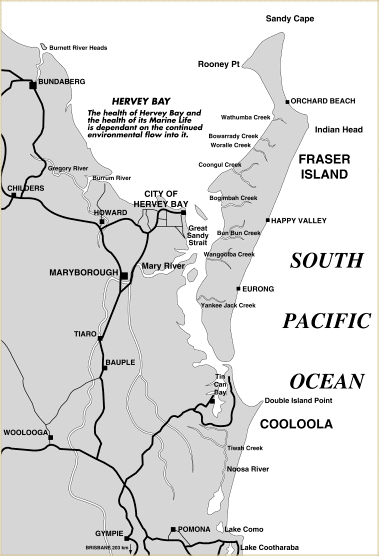The Great Sandy Region’s vast flow of fresh water is not being “wasted” when it runs into the sea. There are enormous benefits from this freshwater flow which sustains the productivity of the coastal marine environment. If the freshwater flow from the region is diverted, the impacts will be far reaching. Already some of Cooloola’s streams natural flows into the marine environment are being tapped for urban water supplies despite Noosa’s determination to avoid touching the Noosa River system. Now there is advocacy to exploit Fraser Island’s water to supply one of Australia’s fastest growing cities. The negative impacts of freshwater flowing into the marine environment was dramatically demonstrated in the Great Sandy Region during the1990s when vast areas of seagrass died in for Hervey Bay as a result of increased turbidity. Likewise fertilizer run-off from the mainland farms reaches over 100 kilometres out to sea to cause eutrification of the Great Barrier Reef.
The Threats
As options to get tap more potable water in South East Queensland are being rapidly exhausted, the pressure to take water from Fraser Island, particularly Bogimbah Creek, increases. Likewise, there is an increasing demand for more water from Cooloola National Park to supply the growth of Rainbow Beach, Tin Can Bay and Cooloola settlements.
Limits to Growth
No local authority responsibility is more urgent than providing an adequate, reliable supply of safe, potable water for its residents. Supply of potable water is clearly a factor which can restrict population growth. Great Sandy Region local authorities have managed to cope so far, but this has been mainly accomplished by tapping other catchments. For example, most of Noosa’s water comes from Six Mile Creek in the Mary River catchment.
Without water to drink, to flush toilets and for industry (not to mention gardens) modern urban communities can’t survive. Although the rate of regional population growth has eased off a little, continuing exponential growth is also creating many other infrastructure problems.
The Situation
Already the three major streams which flow into for Hervey Bay, the Mary, Burnett and Burrum Rivers, have been almost completely exploited. Already during drier years there is very little flow from these rivers into Hervey Bay. With the completion of the Paradise Dam on the Burnett River (now a political commitment) most fresh water flowing into for Hervey Bay to nurture the marine environment will come from Fraser Island. If that flow is diminished, then Hervey Bay and its fishery will suffer.
Hervey Bay City: Two major attractions for Hervey Bay’s residents (particularly retirees) are its appeal for recreational fishers and the proximity of Fraser Island with its magnificent attractions. Taking water from Fraser Island would compromise both attractions. It would also dramatically change the lifestyle by urban sprawl. Those who like the City of for Hervey Bay at its current size will have many regrets. Accommodating an increased population would help kill the goose which lays the golden egg.
Noosa Shire: Noosa Shire has long recognized the significance of the magical Noosa River to its citizens. The shallow lake system in the lower sections of the Noosa River, particularly Lake Cootharaba and Cooroibah are particularly sensitive to changes in salinity if the natural flow of the Noosa River and Kin Kin Creek are reduced. Noosa has steadfastly resisted the temptation to allow its population to grow beyond its capacity to take water without tapping the Noosa River. It has installed a population cap.
Cooloola Shire: Although there is a limit on the volume of water which can be taken from Teewah Creek and the other sources within the National Park , the Cooloola Shire is continuing to challenge this limit. Cooloola communities are being encouraged and allowed to grow in an attempt to force an increase in the amount of water which can be extracted.
Urban Water Options
Most options to increase the supply of potable water are either very expensive or unpopular:
- Establishing population caps to match available water;
- exploiting other catchments;
- water conservation measures;
- recycling grey water; or
- installing desalination plants
- Population cap: Noosa Shire has implemented a population cap by limiting further subdivisions. This means that when all existing subdivisions are built on there will be no further population growth. The effect of this has been very popular. Residents now know that their community will stabilize. Real estate values have soared. Business has “certainty.” It can plan for the known future. This is an option which more local authorities now need to consider more seriously, particularly for Hervey Bay.
- Exploiting other catchments: These options are rapidly drying up as the South East Queensland population booms. The City of Hervey Bay is reaching the limit rapidly. The Burrum River catchment is almost fully. The Mary holds little prospects as upstream communities and agriculture tap virtually all available water upstream.
- Water Conservation: Australia generally has one of the world’s highest per capita water consumption. Water conservation options include:
- encouraging households to install rainwater tanks even if the water caught is only used on gardens;
- increasing the user pays price which takes full account of the environmental cost of collecting and supplying water;
- rationing; and
- public education on the need to conserve water.
- Recycling: Australian local authorities have been slow to explore the option of reusing “grey” water which has been used for washing and flushing for more washing and flushing after thorough treatment.
- Desalination: The sea is now so polluted that few would feel comfortable about using sea water for human consumption. Some is so polluted that it is no longer safe to obtain salt from it. Apart from economic considerations, there is the cost and there are serious environmental impacts. Desalination, using present membrane technology, requires a lot of fossil fuel. This creates for exhaust emissions with serious implications for climate change.
Maintaining Great Sandy Region’s Environmental Flow
Water from Fraser Island and Cooloola’s streams is nourishing Hervey Bay, regional estuaries and the adjacent sea while other regional streams cease to flow. It is therefore vital to maintain the full environmental flow from these streams to sustain Southern Queensland’s marine biodiversity.
Freshwater to the Sea Isn’t Wasted
Most studies on environmental flows have focussed on maintaining environmental flows for the health of the river systems themselves. Little work has been done on the benefits to the But stream flows extend far into the marine environment. This has been demonstrated by negative impacts of pollutants carried out to the Great Barrier Reef and in Hervey Bay. While negative impacts are self-evident, the positive benefits are less known.
Marine Life: A recent study on the effect of reducing the environmental flow of Queensland’s Fitzroy River by the Water Infrastructure Task Force showed the impact of the freshwater flow on barramundi movement and growth. Species more common than barramundi in Hervey Bay, Tin Can Bay and the Noosa River estuaries are just as sensitive.
There is accumulating evidence now indicating that the health of tidal wetlands and mangroves as well as the fisheries also depend on a continued flow of fresh water.
It is widely recognized that fish are extremely sensitive to very subtle changes in water quality. Almost imperceptible changes in salinity, pH and turbidity can be significant. All are affected by changes in fresh water flow.
The main flow of fresh water into for Hervey Bay in the past came from the Mary, Burrum and Burnett catchments. Diversion for irrigation and other uses has reduced this to a third of its natural flow. This makes maintaining 100% environmental flow from the small streams on Fraser Island is critical to maintaining Hervey Bay‘s marine vitality. Similarly Tin Can Bay and the Noosa River are such small estuaries that they have little tolerance to any further reduction of environmental flow by tapping of any more of Cooloola’s water.
Salinity: The marine environment to responds to salinity changes. Certain species concentrate where the marine environment is less saline. Likewise some fish respond to hyper-saline conditions. Maintaining the level of salinity is therefore critical. This means maintaining natural flows.
pH: pH is the measure of acidity in the water. Fish are extremely vulnerable to pH changes and even minor changes can cause ulceration. Release of a small amount of acid resulting from disturbing acid sulphate soil affects not only fish, but even marine algae with deleterious consequences. Thus the natural flow from the myriads of small streams in the Great Sandy Region is critical in maintaining pH.
Detritus and nutrients: Great Sandy Region streams also carry a significant amount of detritus and nutrients. The ground water flowing from the sand masses contains significant phosphate. Nutrient input from these natural streams is largely responsible for nourishing the vast sea grass beds of Hervey Bay. Sea grass supports much marine life including prawns and endangered species including sea turtles and dugong. Other species rely on the detritus.
Mangroves and Wetlands: Mangroves are the world’s most productive ecosystems. At Queensland’s Missionary Bay each hectare of mangroves results in 500 tonnes of prawns annually. Mangroves are also fish habitats and nurseries for many species. It is now clearly established in Queensland that when environmental flows are cut off as a result of barrages or causeways, the mangroves downstream suffer. This has already been observed in Central Queensland, Cairns and Stradbroke Island.
Depleting mangroves depletes other marine life

Major Environmental Flows in the Great Sandy Region
Bogimbah Creek: Bogimbah Creek is Fraser Island’s largest flowing stream. It also has the Great Sandy Region’s greatest diversity of mangroves. An Australian Marine Conservation Society study in 1974 that the occurrence of the Cannonball (Xylocarpus) Mangrove and the large concentration of Brugeiera mangroves there was the result of its large fresh water flow. Maintaining this flow is critical to the survival of these species. This is the only record of Xylocarpus in the Great Sandy Region. The health of the Great Sandy Region fishery will be jeopardised if Bogimbah Creek water is piped to the mainland
Cooloola Creeks: Teewah Creek contributes very significantly to the health of ecosystem of the Noosa River and the productivity of its tidal lakes and estuary. Seerys Creek is the largest freshwater stream flowing into Tin Can Bay. Any depletion of its flow will be reflected in the productivity of the Tin Can Bay estuary. There needs to be a population cap on the Tin Can Bay, Rainbow Beach and Cooloola Village communities to sustain life in this estuary.
Discharges from Great Sandy Region’s fresh-water streams have already had a huge impact on Hervey Bay’s marine environment. Great Sandy Strait and Hervey Bay have already lost huge flocks of black swans which occurred until the 1960s. There was a decimation of the dugong population in the 1990s. Water flows from streams may be responsible for recent Lyngbya outbreaks and turtle deaths.
The water flows into the Great Sandy Region should be maintained as natural, unpolluted and undiminished as possible.
This Educational Supplement was prepared for the Great Sandy Region Conservation Council. April, 2001
